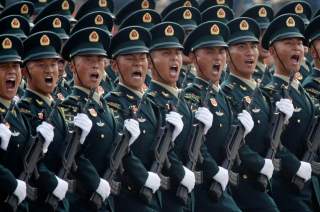Not Good: This Report Warns China Could Beat America in a Fight by 2049
If not sooner.
Key point: Beijing is racing ahead with modernizing its forces and tipping the regional balance in its favor. Without a counter plan from America, it is only a matter of time before China is able to assert dominance in the Western Pacific.
Chinese leaders have laid out a plan for deploying the world’s best-armed forces no later than 2049. If the United States is to prevent China from becoming the world’s leading military power, it needs a plan of its own.
That’s the sobering warning in a new report for the Center for a New American Security by former deputy defense secretary Robert Work and co-author Greg Grant.
Chinese leaders’ resolve hardened in 1991 as they watched the U.S.-led coalition pummel Iraqi forces with seemingly ceaseless barrages of precision-guided munitions.
“A key lesson China took from the 1991 Desert Storm campaign was to strike hard and fast during war’s earliest stages, as initiative once lost would be all but impossible to regain against an opponent capable of 24-hour, all-weather guided-munitions bombardment,” Work and Grant wrote.
By the mid-1990s the senior leadership of the People’s Liberation Army realized “they were engaged in a long-term military-technical competition with the United States, and their strategic aims would necessarily be achieved through a series of distinct temporal phases.”
Phase one would see the Chinese military compete with the United States from a position of technological inferiority. Chinese military writings in the late 1990s and early 2000s explored and emphasized ways to defeat a more technologically advanced adversary, until such time that their modernization efforts were able to narrow the advantages enjoyed by the U.S. military. In particular, the PLA would have to accommodate some period of time in which it lacked “deep and multidirectional strike capabilities” comparable to those of the U.S. military.
Phase two would occur when the Chinese achieved a position of rough technological parity in guided munitions and battle network warfare, making it far more likely China might be able to deter a U.S. military intervention in the East Asian littoral.
And phase three would represent the desired end state, when the Chinese military would establish a position of outright technological superiority over U.S. military forces, enabling the PLA to confidently move out of its first island chain bastion and push U.S. forces out to the second island chain [east of Japan and The Philippines] and even beyond.
In 2019 China is still in phase one. But phase two is looming as China’s economy expands and Chinese technology improves, in part owing to widespread industrial espionage.
China’s theft of major technologies is one key tenet of the PLA’s plan. In addition, Beijing’s armed forces are “[d]eveloping the capabilities and concepts to conduct ‘systems destruction warfare’ —the crippling of the U.S. battle network’s command, control, communication and intelligence systems.”
The Chinese also are planning on:
Attacking effectively first by amassing an arsenal of long-range precision missiles and advanced targeting systems that provide a high probability of penetrating U.S. battle network defenses in the opening stages of a conflict.
Developing “Assassin’s Mace” capabilities—what [the U.S. Defense Department] terms “black capabilities”—that are held in reserve until unveiled in the event of war, to surprise the adversary with attacks from unexpected vectors.
Becoming the world leader in artificial intelligence and then deploying that technology for military superiority.
“It is long past time for the Department of Defense to craft a measured response,” Work and Grant wrote. ”It must develop the operational concepts, systems and platforms to allow the joint force to prevail against concerted Chinese attempts to deconstruct and destroy U.S. operational battle networks.”
It must develop the operational concepts, systems and platforms to allow the U.S. joint force to fire first, effectively, and to ride out Chinese guided munitions salvos if it cannot. It must respond to the Chinese A.I. challenge and ensure it remains ahead in this critical technological competition.
More broadly, China appears to be driving the military-technical competition in critical areas such as quantum science, biotechnology, hypersonics and ballistic and cruise missiles. The joint force must compete more aggressively—and better yet, create new competitive technologies.”
If the Pentagon fails, by 2049 it could find itself on the defensive
David Axe serves as Defense Editor of the National Interest. He is the author of the graphic novels War Fix, War Is Boring and Machete Squad. This first appeared earlier in 2019.
Image: Reuters.

